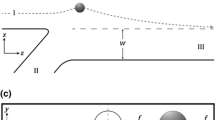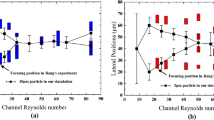Abstract
The recent popularity of inertial microfluidic devices has driven attention towards the behavior of particles in flows within curvilinear microchannels for particle separation and concentration applications. The robust technique of inertial focusing is particularly advantageous in such applications, not only because curved geometries can greatly reduce the footprint of a lab-on-chip devices, but also because the coupling of secondary Dean flows to inertial forces allows for exquisite particle manipulations. However, the ability to accurately predict the behavior of inertial particles in a curvilinear channel is often based on empirical results, as the commonly used theoretical models treat the effects of Dean flow on an inertial particle to be a consequence of the undisturbed velocity field. In particular, this simplification is problematic when the size of the particle is comparable to that of the confining channel. Here we present the first complete direct numerical model that directly simulates a particle within a confined curvilinear flow. This numerical model allows us to not only investigate the three-dimensional focusing behavior of inertial particles but also determine the applicability of the point particle assumptions previous researchers have proposed. Finally, we propose a more computationally efficient second-order model that takes into account the full physics by relying on a perturbation expansion of the lateral forces, where the perturbation parameter is the curvature ratio of the channel. This simpler model can be used to efficiently and accurately predict the behavior of particles in complex channel geometries where the curvature may not be constant.





Similar content being viewed by others
References
Bhagat AAS, Kuntaegowdanahalli SS, Papautsky I (2008) Continuous particle separation in spiral microchannels using dean flows and differential migration. Lab Chip 8:1906–1914
Chun B, Ladd AJC (2006) Inertial migration of neutrally buoyant particles in a square duct: An investigation of multiple equilibrium positions. Phys Fluids 18:031704
Dean W (1927) Xvi. note on the motion of fluid in a curved pipe. Lond Edinb Dublin Philos Mag J Sci 4:208–223
Di Carlo D, Irimia D, Tompkins RG, Toner M (2007) Continuous inertial focusing, ordering, and separation of particles in microchannels. Proc Natl Acad Sci 104:18892–18897
Di Carlo D, Edd JF, Humphry KJ, Stone HA, Toner M (2009) Particle segregation and dynamics in confined flows. Phys Rev Lett 102:094503
Dinler A, Okumus I (2018) Inertial particle separation in curved networks: a numerical study. Chem Eng Sci 182:119–131
Garcia M, Ganapathysubramanian B, Pennathur S (2019) A linearised model for calculating inertial forces on a particle in the presence of a permeate flow. J Fluid Mech 861:253–274
Gossett DR, Di Carlo D (2009) Particle focusing mechanisms in curving confined flows. Anal Chem 81:8459–8465
Ho BP, Leal LG (1974) Inertial migration of rigid spheres in two-dimensional unidirectional flows. J Fluid Mech 65:365–400
Kim J et al (2016) Inertial focusing in non-rectangular cross-section microchannels and manipulation of accessible focusing positions. Lab Chip 16:992–1001
Lee DJ, Brenner H, Youn JR, Song YS (2013) Multiplex particle focusing via hydrodynamic force in viscoelastic fluids. Sci Rep 3:3258
Lim DSW, Shelby JP, Kuo JS, Chiu DT (2003) Dynamic formation of ring-shaped patterns of colloidal particles in microfluidic systems. Appl Phys Lett 83:1145–1147
Liu C, Hu G, Jiang X, Sun J (2015) Inertial focusing of spherical particles in rectangular microchannels over a wide range of Reynolds numbers. Lab Chip 15:1168–1177
Martel JM, Toner M, Elabbasi N, Quinn D, Bergstorm J (2013) Modeling inertial focusing in straight and curved microfluidic channels. COMSOL News. https://www.comsol.com/offers/comsolnews13
Martel JM et al (2015) Continuous flow microfluidic bioparticle concentrator. Sci Rep 5:11300
Martel JM, Toner M (2012) Inertial focusing dynamics in spiral microchannels. Phys Fluids 24:032001
Martel JM, Toner M (2013) Particle focusing in curved microfluidic channels. Sci Rep 3:3340
Maxey MR, Riley JJ (1998) Equation of motion for a small rigid sphere in a nonuniform flow. Phys Fluids 26:883
Nathamgari SSP et al (2015) Isolating single cells in a neurosphere assay using inertial microfluidics. Lab Chip 15:4591–4597
Nivedita N, Ligrani P, Papautsky I (2017) Dean flow dynamics in low-aspect ratio spiral microchannels. Sci Rep 7:44072
Norouzi M, Biglari N (2013) An analytical solution for Dean flow in curved ducts with rectangular cross section. Phys Fluids 25:053602
Ozbey A, Karimzadehkhouei M, Akgönül S, Gozuacik D, Koşar A (2016) Inertial focusing of microparticles in curvilinear microchannels. Sci Rep 6:38809
Pedrol E, Massons J, Díaz F, Aguiló M (2018) Two-way coupling fluid-structure interaction (FSI) approach to inertial focusing dynamics under dean flow patterns in asymmetric serpentines. Fluids 3:62
Phrom C, Stark H (2014) Feedback control of inertial microfluidics using axial control forces. Lab Chip 14:2115–2123
Rasooli R, Çetin B (2018) Assessment of Lagrangian modeling of particle motion in a spiral microchannel for inertial microfluidics. Micromachines 9:433
Sarkar A, Hou HW, Mahan AE, Han J, Alter G (2016) Multiplexed affinity-based separation of proteins and cells using inertial microfluidics. Sci Rep 6:23589
Segre G, Silberberg A (1961) Radial particle displacements in Poiseuille flow of suspensions. Nature 189:209–210
Wang L, Dandy DS (2017) High-throughput inertial focusing of micrometer- and sub-micrometer-sized particles separation. Adv Sci 4:1700153
Yuan C, Pan Z, Wu H (2018) Inertial migration of single particle in a square microchannel over wide ranges of Re and particle sizes. Microfluid Nanofluidics 22:102
Zhang J, Li W, Li M, Alici G, Nguyen N-T (2014) Particle inertial focusing and its mechanism in a serpentine microchannel. Microfluid Nanofluidics 17:305–316
Acknowledgements
The authors would like to thank Professor Paolo Luzzato-Fegiz for insightful discussion regarding rotating reference frames. Mike Garcia was supported by the Institute for Collaborative Biotechnologies through Grants no. W911NF-09-D-0001 and no. W911NF-12-1-0031 through the U.S. Army Research Office. The content of the information does not necessarily reflect the position of the policy of the government, and no official endorsement should be inferred
Author information
Authors and Affiliations
Corresponding author
Additional information
Publisher's Note
Springer Nature remains neutral with regard to jurisdictional claims in published maps and institutional affiliations.
Electronic supplementary material
Below is the link to the electronic supplementary material.
Rights and permissions
About this article
Cite this article
Garcia, M., Pennathur, S. A model for inertial particles in curvilinear flows. Microfluid Nanofluid 23, 63 (2019). https://doi.org/10.1007/s10404-019-2234-x
Received:
Accepted:
Published:
DOI: https://doi.org/10.1007/s10404-019-2234-x




